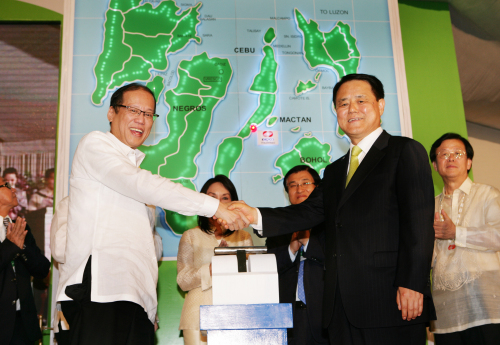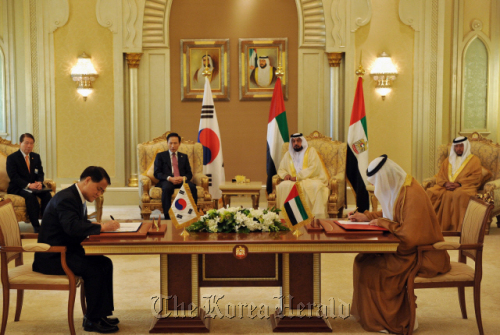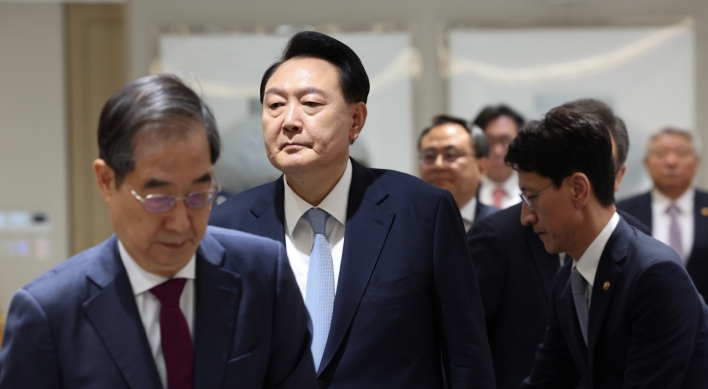Celebrating 50 years in business, company hopes to nearly triple annual sales by 2020
Korea Electric Power Corp. is hoping to more than double its annual revenue as it drives for a spot among the world’s five largest energy companies.
The company, which has its 50th anniversary on Friday, is aiming for annual sales of 85 trillion won ($79 billion), of which 26 trillion won will be raised from overseas, by 2020 to become one of the industry’s five largest players.
Its plan is divided into four categories that are green technology, diversifying business areas, promoting overseas projects and increasing management efficiency.
Of the four categories, the company is placing particular emphasis on environmental technologies and overseas expansion.
Under the plans for its green business, KEPCO will be injecting 3.1 trillion won into securing technologies as part of efforts to push up revenues from related businesses to 14 trillion won by 2020, 700 times higher than the current figure of 20 billion won.
“The company has drawn up detailed plans that include 12 tasks in four categories. The company will also push businesses concerning clean development mechanism to secure 6.9 million ton carbon credits on an annual basis,” the company said. The company said that the four categories are developing eco-friendly power technologies into growth engines, expanding global operations of eco-friendly businesses, establishing a low-carbon, low-energy system and building infrastructure for low-carbon green growth.
Under the plans for developing eco-friendly power technologies into growth engines, the company will be concentrating its resources on eight technological areas including integrated gasification cycle, carbon capture and storage and smart grid. As part of the program KEPCO also hopes to hone world-class capabilities in 25 categories including designing nuclear power plants.
As for expanding global operations of eco-friendly businesses, KEPCO hopes to raise 14 trillion won in annual sales from exporting related technologies such as nuclear power plants and those concerning smart grid and electric vehicle charging infrastructure.
“The company’s strategy is to tackle overseas markets in stages that take into account different regions’ characteristics with regards to different businesses,” KEPCO said.
Korea Electric Power Corp. is hoping to more than double its annual revenue as it drives for a spot among the world’s five largest energy companies.
The company, which has its 50th anniversary on Friday, is aiming for annual sales of 85 trillion won ($79 billion), of which 26 trillion won will be raised from overseas, by 2020 to become one of the industry’s five largest players.
Its plan is divided into four categories that are green technology, diversifying business areas, promoting overseas projects and increasing management efficiency.
Of the four categories, the company is placing particular emphasis on environmental technologies and overseas expansion.
Under the plans for its green business, KEPCO will be injecting 3.1 trillion won into securing technologies as part of efforts to push up revenues from related businesses to 14 trillion won by 2020, 700 times higher than the current figure of 20 billion won.
“The company has drawn up detailed plans that include 12 tasks in four categories. The company will also push businesses concerning clean development mechanism to secure 6.9 million ton carbon credits on an annual basis,” the company said. The company said that the four categories are developing eco-friendly power technologies into growth engines, expanding global operations of eco-friendly businesses, establishing a low-carbon, low-energy system and building infrastructure for low-carbon green growth.
Under the plans for developing eco-friendly power technologies into growth engines, the company will be concentrating its resources on eight technological areas including integrated gasification cycle, carbon capture and storage and smart grid. As part of the program KEPCO also hopes to hone world-class capabilities in 25 categories including designing nuclear power plants.
As for expanding global operations of eco-friendly businesses, KEPCO hopes to raise 14 trillion won in annual sales from exporting related technologies such as nuclear power plants and those concerning smart grid and electric vehicle charging infrastructure.
“The company’s strategy is to tackle overseas markets in stages that take into account different regions’ characteristics with regards to different businesses,” KEPCO said.


“Overseas sales, which have been concentrated in fossil fuel power stations, will be expanded to green models such as nuclear, hydro and renewable energy sources. The company will also raise the level of self-sufficiency in terms of resources to 60 percent from the current 7 percent.”
As part of its plans for establishing a low-carbon, low-energy system, the company said that it would carry out nuclear power plant projects so that such facilities account for 41 percent of its capacity by 2030.
The company’s overseas expansion plans are no less ambitious.
As it targets becoming one of the world’s top five energy and engineering firms, KEPCO is hoping to raise its overseas-generated revenues to 26 trillion won in 2020, which is equivalent to 31 percent of the overall sales target. In comparison, the company raised 2 percent or 1.7 trillion won of its revenues from overseas markets last year.
With about 9.1 trillion won of the 26 trillion won target having been allocated to nuclear and alternative energy-driven power generation, KEPCO’s overseas expansion plans are also closely tied to its green growth strategies.
In driving overseas expansion, the company is hoping to diversify its business portfolio as well as the countries it is operating in.
“Overseas operations, currently concentrated in China and the Philippines, will be expanded to include Africa, central Asia and the Middle East,” the company said.
While the company has included overseas expansion as a key growth engine, KEPCO has been operating outside of Korea for sometime.
Its first venture outside the country began in 1995, when it beat back rivals from Japan and Hong Kong to win a project updating and operating a power plant in the Philippines in 1995.
The company then went on to build a gas-powered power station in the Southeast Asian country.
From 2001, the company entered other Asian markets, and now operates one of the largest wind power businesses in China.
According to the company, its wind power operations in China offer profitability as well as carbon credits. As of December, 13 of KEPCO’s related projects in China had been given UN recognition as clean development mechanisms, and including carbon credits that will be generated from wind power plants under construction, it will secure about 1.2 million tons of carbon credits every year through its China projects.
The highlight of KEPCO’s overseas efforts came in 2009 when a consortium led by KEPCO was chosen for a $20 billion project building four 1,400 megawatt nuclear power stations in the United Arab Emirates.
While the company continues to strive to gain higher ground in the international market, it has come a long way since its launch 50 years ago.
KEPCO, formerly known as Korea Electric Company, was established on July 1, 1961 when the government decided to merge three regional electric companies ― Chosun, Kyungsung and Namsun ― that had been experiencing difficulties.
At the time of KEPCO’s launch, the country was faced with severe power shortages. According to KEPCO, its facilities at the time were capable of generating 322,000 kilowatts but the country’s power demand stood at 435,000 kilowatts.
In response, the government and KEPCO launched a series of five-year plans to boost output.
As a result of four five-year plans conducted between 1962 and 1981, the company’s capacity was pushed up to nearly 983 million kilowatts by the end of 1981.
In 1978, less than 20 years since its establishment, the company’s first nuclear power plant was completed, taking KEPCO’s operations to the cutting edge of power generation.
By Choi He-suk (cheesuk@heraldcorp.com)









![[KH Explains] How should Korea adjust its trade defenses against Chinese EVs?](http://res.heraldm.com/phpwas/restmb_idxmake.php?idx=644&simg=/content/image/2024/04/15/20240415050562_0.jpg&u=20240415144419)








